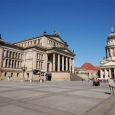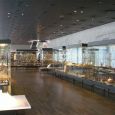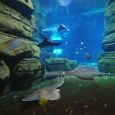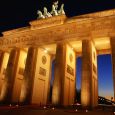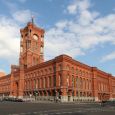Berlin
Advertisement
By Air
Berlin has three airports, each of which serve different roles. Berlin Tegel is the largest and busiest of the three, handling most of the flights from the west. Berlin Schoenefeld, once the main airport for East Berlin, mainly receives flights from Asia, Russia and other European countries. Berlin Tempelhof is the citys oldest airport and handles mainly domestic flights and flights to a few European destinations. All three airports are linked to the city centre by bus and the S-Bahn and U-Bahn.
By Rail
Germanys rail system is justifiably one of the most efficient in Europe and it connects the city to all parts of the country and beyond. Frankfurt, Munich, Hamburg and Bonn have the best rail connections with Berlin, thanks to high-speed intercity express services. From any of these cities, connections can be made to the rest of Europe and the UK.
Until recently, Berlin had two main train stations: Bahnhof Zoo in the west and Ostbahnhof in the east. Getting between the two parts of the city usually requires taking an S-Bahn link to your local station; however, the newly completed Lehrter Bahnhof megastation in Berlin Mitte is expected to gradually replace the others as the citys central train hub, making connections to all parts of the city much easier.
By Bus
Regularly scheduled buses run from over 250 German and European cities to Berlin each day. All arrivals and departures to the city come through the ZOB Omnibusbahnhof am Funkturm in Charlottenburg. Taxi and bus connections are available at the station, and the U-Bahn is nearby.
By Car
The A10 ring road around the city links Berlin with the rest of the country and greater Europe in every direction. The A2 connects with Hanover and the Ruhrgebeit cities, and the A24 links with Hamburg. Travellers from Munich, Nuremburg and Leipzig can reach Berlin via the A9, while the A13 connects the city with Dresden. Drivers from Frankfurt should use the A12, and anyone coming from Poland should take the A11.
Gendarmenmarkt
From Friedrichstrasse it is only a few minutes' walk southwards to Gendarmenmarkt, one of Berlin's most beautiful and harmonious squares. It has as its dominant feature three large buildings forming one group - the Schauspielhaus (Theater), the French Cathedral and the German Cathedral. The square was laid out in the 17th C. and first named the Esplanade, then Lindenmarkt, Mittelstädtischer or Friedrichstädtischer Markt and finally Gendarmenmarkt, because a regiment of Gendarmerie had their guard-house and stables here from 1736-82. When the Academy of Sciences celebrated its 250th anniversary in 1950 it was named Platz der Akademie. Having suffered considerable damage in the Second World War, most of it was rebuilt in its original form
during the GDR period. Following the reunification of Berlin it was once again given the name of Gendarmenmarkt.
On the corner of Französische Strasse and Charlottenstrasse near the square stood the Lutter and Wegner tavern, where E. T. A. Hoffman (whose stories inspired Offenbach's "Tales of Hoffmann") was a regular customer. He also lived in the square.
Berlin Zoo Aquarium
Germanys oldest zoo was founded in 1844 and occupies a large part of the Tiergarten. Although only 91 animals survived the bombings of WWII; today, more than 13,000 animals live here in spacious, natural habitats. The giant pandas alone are worth a visit.
The aquarium is just as impressive as the adjacent zoo. Over 9,000 species of fish, reptiles, insects and other exotic creatures are on display in a modern facility. There is a large terrarium with komodo dragons and tuataras as well as a glass-roofed hippoquarium allowing you to get up close and personal with the hippos.
Dahlem Museums
The three-story building that houses the Dahlem Museums in Berlin was built by Bruno Paul between 1914 and 1923. Originally erected to accommodate the Asiatic Museum, it was subsequently enlarged on several occasions and now houses the Picture Gallery, the Print and Engraving Cabinet (collection of drawings and graphic prints), the Museums of Indian, Islamic and East Asian Art, the Museum of Ethnography and the Sculpture Gallery.
When the new museum building for the European art belonging to the Prussian Cultural Heritage Foundation in Kemperplatz on the west side of the Culture Forum is completed, the Painting Gallery, Sculpture Gallery and Print and Engraving Cabinet will be moved there.
Brandenburg Gate
This integral symbol of Berlin now stands restored in the heart of the city. During the height of the Cold War, the structure was a part of the Berlin Wall, and as such, a symbol of the divided city. Originally designed in 1789, every trip to Berlin should include a visit to this triumphal arch.
Red Town Hall
The successor to the 16th C. town hall in Berlin, the present Red Town Hall was designed by Hermann Friedrich Waesemann and built between 1861-69 - a massive Neo-Renaissance building laid out round three inner courtyards with a tower 74 m/243ft high. The foundation stone was laid in June, 1861, in the presence of King William I, and the first meeting of the Town Council was held at the end of 1865, although the building was in fact not completed until late in 1869. It soon became known as the Red Town Hall, from the red brick of which it was built - and perhaps also on account of the democratic spirit shown by the municipal authorities even in the time of the Empire. In March, 1945, the Town Hall was badly damaged in a bombing raid and it was 1955 before it could be used again.
Knoblauch House
Between 1754-60 the Jewish master tailor Johann Christian Knoblauch constructed a Roccoco building at the corner of Nikolaiplatz and Poststrasse in Berlin's Nikolaiviertel. The house was rebuilt on its original site (No. 23) in 1989. The house of this well-to-do family (whose descendants include Eduard Knoblauch, the architect of the New Synagogue (in Oranienburger Strasse), received such famous visitors as Lessing, Mendelssohn, Wilhelm von Humboldt, Scharnhorst and Baron von Stein. An exhibition forming part of the Märkisches Museum concentrates on the history of the Knoblauch family in rooms furnished in original 19th C. style.
A few steps farther north, on a small courtyard on Poststrasse, stands the court arcade of the medieval town hall. It was originally sited 200 m/220yd to the southeast, but was pulled down and re-erected in the Babelsberg Palace park, where it still stands today.
Information not available


